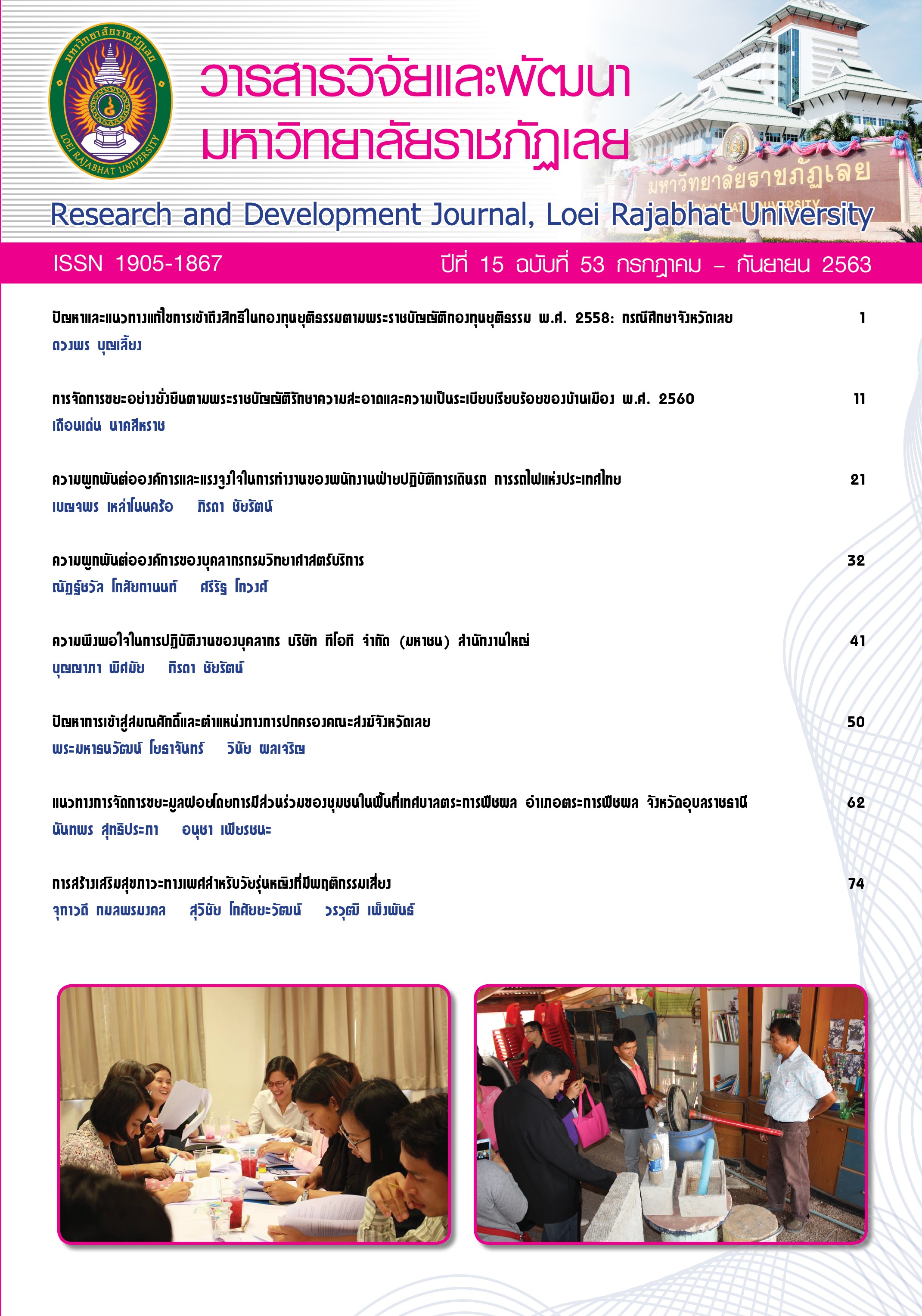Sexual Wellbeing Promotion for Risk Female Adolescent
Keywords:
living style, health promotion, sexual risk, female adolescentAbstract
This qualitative phenomenological research is aimed to reveal life style of female adolescent with sexual risk behavior self-adaptation resulting from having risky sex behavior of female adolescent and the guidelines for enhancing sexual health for female adolescents with risk behavior. The samples were female adolescent with sexual risk behavior, 20 people. Semi-structured interviews are used for data collected, from April to July 2019.The methods of data collection included in- depth interview and focus group discussion. Data were analyzed by the content analysis technique. The result were as follows:
1. The most risking life style or female adolescent to sexual wellbeing were having boyfriend, facebook surfing and living together with boyfriend. These life style leaded to closeness, trustworthiness, curiosity, and discourage to refuse for having sex and even lead to get an unexpected pregnancy. The pregnancy creates radical changes in body, mind and social problem. Knowing that she was pregnant, mostly, the lady would inform his and her parent to ask for forgiveness before having antenatal care.
2. After being expose to the risk to sexual wellbeing, the female adolescent will adjust herself (or self-adaptation) in four aspects; body, self- concept, role and duty, and interdependency. Receiving helps and forgiveness from parents as well as care from her husband, the female adolescent would forgive herself, feel encourage to look after herself, eventually plan for her future to be.
3. There are two ways to promote the sexual well-being for female adolescent. First, the guideline for helping female adolescent after having the risk behavior is to give moral support/ forgiveness/ employment/income and education. Second, the guideline for prevention of sexual risk behavior of female adolescent is the rejection skill which can be embedded in family and school to collaborate and communicate through their childhood.
References
กระทรวงการพัฒนาสังคมและความมั่นคงของมนุษย์, สํานักงานปลัด. (2556). รายงานการวิเคราะห์สถานการณ์ทางสังคม. โครงการพัฒนาระบบข้อมูลสารสนเทศในรูปแผนที่ทางสังคมปีงบประมาณ 2556. กรุงเทพฯ: กระทรวงการพัฒนาสังคมและความมั่นคงของมนุษย์.
กระทรวงศึกษาธิการ, กรมวิชาการ. (2553). แนวทางการจัดกิจกรรมพัฒนาผู้เรียน: ตามหลักสูตรแกนกลางการศึกษาขั้นพื้นฐาน พุทธศักราช 2551 (พิมพ์ครั้งที่ 2). กรุงเทพฯ: โรงพิมพ์ชุมนุมสหกรณ์การเกษตรแห่งประเทศไทย จำกัด.
กระทรวงสาธารณสุข, กรมควบคุมโรค, สำนักระบาดวิทยา. (2553). สถานการณ์โรคเอดส์ในประเทศไทย รายงาน ณ วันที่ 31 ตุลาคม 2553. นนทบุรี: กระทรวงสาธารณสุข.
กระทรวงสาธารณสุข, กรมควบคุมโรค, สำนักระบาดวิทยา. (2561). สถานการณ์โรคติดต่อทางเพศสัมพันธ์ในวัยรุ่นและเยาวชนอายุ 15-24 ปี 2553-2561. นนทบุรี: กระทรวงสาธารณสุข.
กระทรวงสาธารณสุข, กรมอนามัย, สำนักอนามัยการเจริญพันธุ์. (2557). การตั้งครรภ์ในวัยรุ่น:นโยบาย แนวทางการดำเนินงานและติดตามประเมินผล. กรุงเทพฯ: ชุมนุมสหกรณ์การเกษตร แห่งประเทศไทย.
กระทรวงสาธารณสุข, กรมอนามัย, สำนักอนามัยการเจริญพันธุ์. (2559). สถานการณ์อนามัยการเจริญพันธุ์ในวัยรุ่นและเยาวชน. กรุงเทพฯ: ชุมนุมสหกรณ์การเกษตรแห่งประเทศไทย.
ชลนิทรา แสงบุราณ. (2551). รูปแบบการเลี้ยงดูและการสื่อสารเรื่องเพศระหว่างมารดาและบุตรสาวต่อพฤติกรรมทางเพศของวัยรุ่นตอนต้น (วิทยานิพนธ์มหาบัณฑิต). มหาวิทยาลัยมหิดล, กรุงเทพฯ.
เชาว์ฤทธิ์ แดงซอน. (2552). การพูดคุยเรื่องเพศระหว่างพ่อแม่กับลูกวัยรุ่นในชุมชนชนบทในภาคเหนือของประเทศไทย (วิทยานิพนธ์มหาบัณฑิต). มหาวิทยาลัยมหิดล, กรุงเทพ.
ทรงพร จันทรพัฒน์. (2543). การพยาบาลภาวะจิตสังคมของหญิงตั้งครรภ์. สงขลา: ภาควิชาการพยาบาลสูติ-นรีเวชและผดุงครรภ์ คณะพยาบาลศาสตร์ มหาวิทยาลัยสงขลานครินทร์.
บุญฤทธิ์ สุขรัตน์. (2557). การตั้งครรภ์ในวัยรุ่น: นโยบาย แนวทางการดำเนินงาน และติดตามประเมินผล. นนทบุรี: กระทรวงสาธารณสุข.
ยุวดี งอมสงัด, รุ่งรัตน์ ศรีสุริยเวศน์, และพรนภา หอมสินธุ์. (2562). ปัจจัยที่มีอิทธิพลต่อความรอบรู้ด้านสุขภาพเพื่อป้องกันการตั้งครรภ์ในนักเรียนวัยรุ่นหญิง จังหวัดศรีสะเกษ. วารสารสาธารณสุข มหาวิทยาลัยบูรพา, 14(2), 37-49.
สำนักงานคณะกรรมการพัฒนาการเศรษฐกิจและสังคมแห่งชาติ. (2556). แม่วัยใส ความท้าทายการตั้งครรภ์ในวัยรุ่น. กรุงเทพฯ: แอดวานส์ปริ้นติ้งจำกัด.
สุคนธ์ ไข่แก้ว. (2547). ตั้งครรภ์วัยรุ่น: การส่งเสริมสุขภาพ. วารสารพยาบาลศาสตร์, 22(1), 20-27.
สุวชัย อินทรประเสริฐ และคณะ. (2551). คู่มือการให้บริการวางแผนครอบครัว สำหรับเจ้าหน้าที่สาธารณสุข. นนทบุรี: โรงพิมพ์องค์การสงเคราะห์ทหารผ่านศึก.
Aquilera, D. C., & Messick, J. B. (1978). Crisis Intervention: Theory and Methodology (5th ed.). St. Louis: Mosby
Andrew, H. A. & Roy, C. (1991). Essential of the Roy adaptation model. In S. C. Roy and H. Andrew (eds.), The Roy adaptation model: The definitive statement. Connecticut: Appleton & Lange.
Karen. B. O. (2002). Child and Adolescent: An Integrated Approach. Southblank: Wadsworth/ I’homson Learning.
Downloads
Published
How to Cite
Issue
Section
License
ข้อความที่ปรากฎในวารสารฉบับนี้เป็นความคิดเห็นของผู้เขียนแต่ละท่าน สถาบันวิจัยและพัฒนา มหาวิทยาลัยราชภัฏเลย และกองบรรณาธิการ ไม่จำเป็นต้องเห็นด้วยและไม่มีส่วนรับผิดชอบใดๆ
สถาบันวิจัยและพัฒนา มหาวิทยาลัยราชภัฏเลย ขอให้ผู้อ่านอ้างอิงในกรณีที่ท่านคัดลอกเนื้อหาบทความในวารสารฉบับนี้






